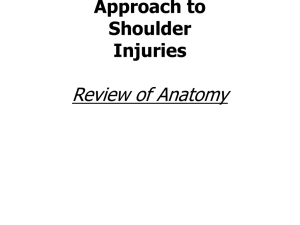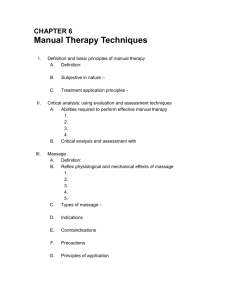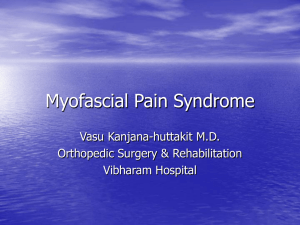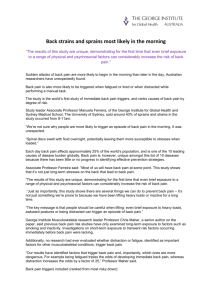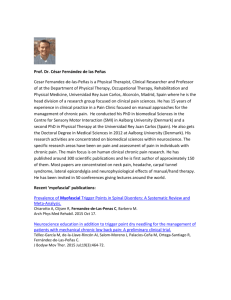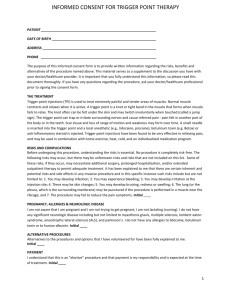Myofascial Trigger Points – Inservice by Bridget Lavaveshkul
advertisement
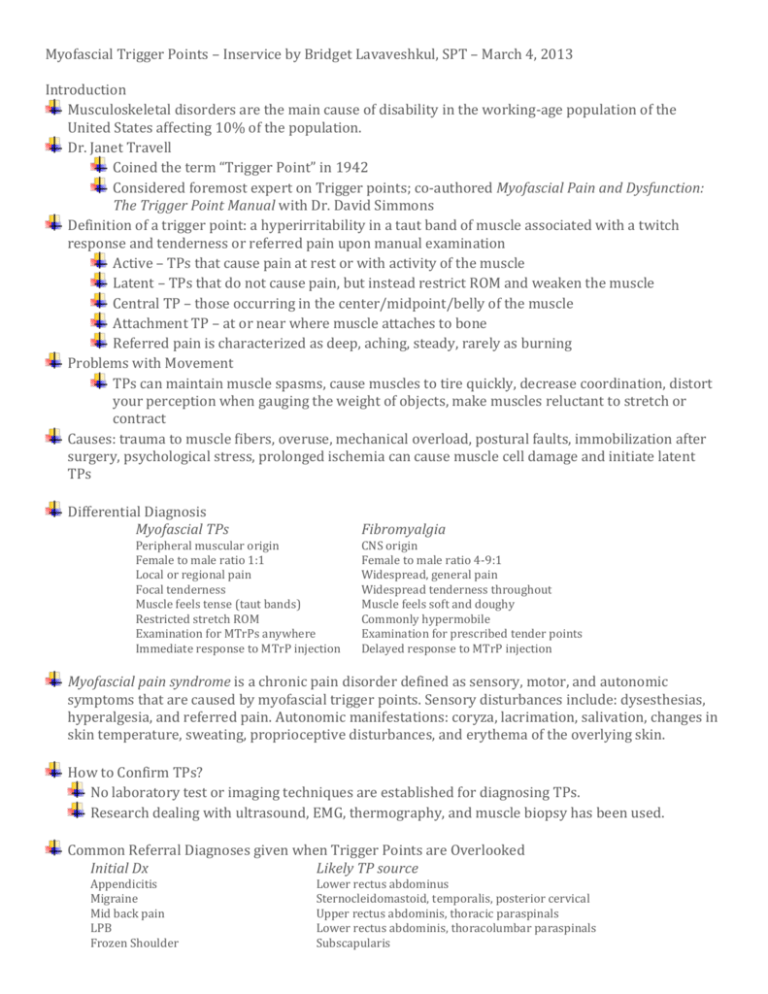
Myofascial Trigger Points – Inservice by Bridget Lavaveshkul, SPT – March 4, 2013 Introduction Musculoskeletal disorders are the main cause of disability in the working-age population of the United States affecting 10% of the population. Dr. Janet Travell Coined the term “Trigger Point” in 1942 Considered foremost expert on Trigger points; co-authored Myofascial Pain and Dysfunction: The Trigger Point Manual with Dr. David Simmons Definition of a trigger point: a hyperirritability in a taut band of muscle associated with a twitch response and tenderness or referred pain upon manual examination Active – TPs that cause pain at rest or with activity of the muscle Latent – TPs that do not cause pain, but instead restrict ROM and weaken the muscle Central TP – those occurring in the center/midpoint/belly of the muscle Attachment TP – at or near where muscle attaches to bone Referred pain is characterized as deep, aching, steady, rarely as burning Problems with Movement TPs can maintain muscle spasms, cause muscles to tire quickly, decrease coordination, distort your perception when gauging the weight of objects, make muscles reluctant to stretch or contract Causes: trauma to muscle fibers, overuse, mechanical overload, postural faults, immobilization after surgery, psychological stress, prolonged ischemia can cause muscle cell damage and initiate latent TPs Differential Diagnosis Myofascial TPs Peripheral muscular origin Female to male ratio 1:1 Local or regional pain Focal tenderness Muscle feels tense (taut bands) Restricted stretch ROM Examination for MTrPs anywhere Immediate response to MTrP injection Fibromyalgia CNS origin Female to male ratio 4-9:1 Widespread, general pain Widespread tenderness throughout Muscle feels soft and doughy Commonly hypermobile Examination for prescribed tender points Delayed response to MTrP injection Myofascial pain syndrome is a chronic pain disorder defined as sensory, motor, and autonomic symptoms that are caused by myofascial trigger points. Sensory disturbances include: dysesthesias, hyperalgesia, and referred pain. Autonomic manifestations: coryza, lacrimation, salivation, changes in skin temperature, sweating, proprioceptive disturbances, and erythema of the overlying skin. How to Confirm TPs? No laboratory test or imaging techniques are established for diagnosing TPs. Research dealing with ultrasound, EMG, thermography, and muscle biopsy has been used. Common Referral Diagnoses given when Trigger Points are Overlooked Initial Dx Likely TP source Appendicitis Migraine Mid back pain LPB Frozen Shoulder Lower rectus abdominus Sternocleidomastoid, temporalis, posterior cervical Upper rectus abdominis, thoracic paraspinals Lower rectus abdominis, thoracolumbar paraspinals Subscapularis Subacromial Bursitis Radiculopathy C6 Middle Deltoid Pectoralis minor, scalene Treatment Techniques Trigger point injection Local anesthetic which may or may not include a corticosteroid is injected at site of TP Indicated for those who have symptomatic active TPs that produce a twitch response to pressure and create pattern of referred pain. Dry Needling Same as trigger point injection, but without medication Found to be just as effective as trigger point injection, however most often increased soreness Spray and Stretch Helps to inactivate TPs, relieve muscle spasm, reduce referred pain Passive stretch of target muscle while spraying Fluori-Methan or ethyl chloride topically Drop in skin temp provides temporary anesthesia blocking spinal stretch reflex on pain sensation, thus able to passively stretch muscle through normal ROM Kostopoulos, D. Effect of topical aerosol skin refrigerant (Spray and Stretch technique) on passive and active stretching. 30 participants, found to be effective; able to achieve significant increase in AROM/PROM hip flexion, also females achieved greater pre/post AROM than males MANUAL TECHNIQUES Trigger Point Release Gentle persistent pressure against the palpable tissue barrier in the TP. The first increase in tissue resistance felt is the “barrier.” This point is usually perceived as tender but not painful. Pressure is maintained until clinician feels a release in muscle tension. Effective for acute TPs (before pathologic changes) c goal to train patient to self-manage pain and dysfunction Hanten, W. et al. Effectiveness of a home program of ischemic pressure followed by sustained stretch for treatment of myofascial trigger points. 40 patients c TPs in upper back and neck utilized HEP of theracane and stretches vs active ROM (control) A home program, consisting of ischemic pressure and sustained stretching, was shown to be effective in reducing TP sensitivity and pain intensity in individuals with neck and upper back pain. Hidalgo-Lozano, A. et al. Changes in pain and pressure pain sensitivity after manual treatment of active trigger points in patients with unilateral shoulder impingement: A case series 12 patients c unilateral shoulder impingent attended 4 sessions for 2 weeks. TP release and neuromuscular intervention (longitudinal stroke c slow and painfree pressure) Outcome measures: VAS, Pain pressure threshold levator scapulae, supraspinatus, infraspinatus, pec major This case series has shown that manual treatment of active muscle TrPs can help to reduce shoulder pain and pressure sensitivity in shoulder impingement. Limitations: small sample size, no control group Strain/Counterstrain (SCS) [Positional Release Technique (PRT)] Dr. Lawrence Jones, D.O., an osteopathic physician, first developed SCS/PRT in the 1950's Muscles are passively placed in greatest comfort position. The resultant relaxation of tissue leads to an improvement in vascular circulation and removal of the chemical mediators of inflammation. It improves the function, relieves the tension and eases the musculoskeletal pain Therapist applies gradually increasing pressure to the MTrP until the sensation of pressure becomes one of pressure and pain. Then moves pt into new position with less tension resulting in a subjective reduction of pain of up to 75% Kelencz, C. et al. Trapezius upper portion trigger points treatment purpose in positional release therapy with electromyographic analysis 6 patients aged 44-63 c upper trap tension 10 session 30 minutes each Outcome measures: Mcgill pain questionnaire, EMG The results demonstrated a progressive decrease of pain in each session. The tension was evaluated by the EMG analysis; Tension decreased 31.86% on the right side and 43.38% on the left side Okhovatian, F. Comparison between the immediate effect of manual pressure release and strain/counterstrain techniques on latent trigger point of upper trapezius muscle 66 participants c TPs in upper trap, outcomes: pain pressure threshold, VAS. Three groups: TP, SCS, control (ultrasound) TP release and SCS techniques are superior to sham ultrasound in immediately reducing pain in patients with non-specific neck pain and upper trapezius, but manual TP technique is better than SCS technique. Several studies reported us of SCS in combination with other interventions for cervicothoracic pain, lateral epicondylitis; chronic and acute conditions. Most research dealing c tender points. Differences between Local Tenderness Location Tender Points Yes somatic tissues: muscles, ligaments, tendon, bone Evoked Referred pain No Presence of taut band No Presence of autonomic No phenomena (jump sign or twitch response) vs Trigger Points Yes Muscle and/or its fascia Yes Yes Yes Active Release Technique (ART) During active release therapy, the clinician applies a combination of deep digital tension at the area of tenderness and the patient actively moves the tissue through the adhesion site from a shortened to a lengthened position. Michael Leahy, DC, CCSP The goal is to improve tissue function by reducing tissue stiffness, fibrosis, and/or adhesion James W. George. The effects of active release technique on hamstring flexibility: a pilot study 20 healthy males ART on origins and insertions of hamstrings and dorsal sacral ligament Outcome Measure: sit and reach Results: Mean score increased 8.3 cm Limitations: small sample size included only young, healthy males; Measurements taken immediately following the ART treatment; thus, how long the increased flexibility might last is unknown. no comparative interventions included such as PNF or massage. Scott D Howitt .Lateral epicondylosis: a case study of conservative care utilizing ART® and rehabilitation 51 year old, recreational tennis player Treatment: 6x over 2 weeks with ART at common origin of extensor carpi radialis brevis/longus, and supinator. 20 minutes IFC, 10 minutes ice A combination of soft tissue therapy, rehabilitation, and therapeutic allowed for the athletic patient to return to play Scott Howitt DC. The conservative treatment of Trigger Thumb using Graston Techniques and Active Release Techniques Case study 42 y.o. 8 rx over 4 weeks of ART and Graston technique followed by ice and self-mobs to thenar eminence and 1st digit. Outcome measures: subjective pain rating, ROM End of treatment, no pain and only slight irritation in capsule in forced full flexion F/U 14 months after D/C no further complications, complete resolution, pre-injury status Appears ART has a higher success rate with lateral epicondylitis, carpal tunnel, and overuse syndromes. I’ve worked the trigger points out, now what? Long term goal of returning muscle to normal length and motor function Warm up Manual Once trigger points are inactivated, utilize strengthening therex and stretching to help increase ROM in pain free range If the muscles are not returned to normal length, there is a greater likelihood the TPs will reoccur. Conclusion Manual techniques such as traditional TP release, SCS/PRT, and ART have all been shown to be safe and effective at treating TPs. Used as an adjunct c other interventions can benefit our patients Referral Pain Patterns and Trigger Point Diagrams http://www.triggerpoints.net/ References Davies, C., Simons, G., Davies, A. The Trigger Point Therapy Workbook: Your Self-Treatment Guide for Pain Relief. New Harbingers Publications. 2004. 32-38. George, J., Tunstall, A., Tepe, R., Skagg, C. The effects of active release technique on hamstring flexibility: a pilot study. Journal of Manipulative and Physiological Therapeutics. 2006; 29: 224-227. Hanten, W., Olson, S., Butts, N., Nowicki, A. Effectiveness of a home program of ischemic pressure followed by sustained stretch for treatment of myofascial trigger points. Physical Therapy. 2000; 80: 997-1003. Hidalgo-Lozano, A., Fernandez-de-las-Penas, C., Diaz-Rodriguez, L., Gonzalez-Iglesias, G., Palacios-Cena, D., Arroyo-Morales, M. Changes in pain and pressure pain sensitivity after manual treatment of active trigger points in patients with unilateral shoulder impingement: a case series. Journal of Bodywork and Movement Therapies. 2011; 15: 399-404. Hong, CZ. Lidocaine injection versus dry needling to myofascial trigger points. The importance of the local twitch response. Am J Phys Med Rehabil. 1994; 73: 256-63. Howitt, S. Lateral epicondylosis: a case study of conservative care utilizing ART and rehabilitation. J Can Chiropr Assoc 2006; 50(3). 182-189. Howitt, S., Wong, J., Zabukovec, S. The conservative treatment of trigger thumb using Graston Techniques and active release technique. J Can Chiropr Assoc 2006; 50(4). 249-254. Huguenin, L. Myofascial trigger points: the current evidence. Physical Therapy in Sport. 2004; 5: 2-12. Kelencz, C., Tarini, V., Amorim, C. Trapezius upper portion trigger points treatment purpose in positional release therapy with electromyographic analysis. Kostopoulos, D., Rizopoulos, K. Effect of topical aerosol skin refrigerant (spray and stretch technique) on passive and active stretching. Journal of Bodywork and Movement Therapies. 2008. 12;2: 96-104. Okhovatian, F., Mehdikhani R., Naimi, S. Comparison between the immediate effect of manual pressure release and strain/conunterstrain techniques on latent trigger point of upper trapezius muscle. Clinical Chiropractic. 2012. 15;2: 55-61. Simons, D., Travell, J., Simons, L. Myosfasical Pain and Dysfunction 1: The Trigger Point Manual. Upper Half of Body. Williams and Wilkin 1999. 17, 21-23, 31-44.
